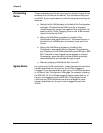
5-2
Chapter 5
Cajun P550/P880/P882 Switch User Guide
Physical Port Features
This section describes the following features that are available when
configuring the physical parameters on the ports:
■ Autonegotiation
■ Flow Control
Auto-
negotiation
Autonegotiation is an extension of the link test methods used by
10Base-T and 10Base-FL to verify the integrity of the link between
devices. Autonegotiation advertises a device's abilities by encoding a
16-bit data packet, called a link code word (LCW), within a burst of 17
to 33 link pulses, called a fast link pulse (FLP) burst. FLP bursts have an
approximate duration of 2 µs and are transmitted in 16.8 µs intervals
(the same interval as for the normal link pulses used by 10Base-T and
10Base-FL).
However, this does not hold true for the Half Duplex/Full Duplex
(HD/FD) selection. If a non-autonegotiating device running FD is
connected to a negotiating device, the negotiating device runs at
HD, and the link does not operate properly.
* Note: A Gigabit Ethernet device negotiates at HD or FD, not
speed.
The LCW contains two fields (the selector field and the technology
ability field), which together serve to identify a device's capabilities.
It may seem that because the FLP and the normal link pulse use the
same interval at the same frequency, older devices may not be
compatible with auto-negotiation. This is, however, not the case. For
example, a 10Base-T device that does not have auto-negotiation
capabilities sees FLP bursts simply as a link test signal. A 10Base-T
device will respond to the FLP burst with its usual normal link pulse
signal. At the other end of the link, a 10/100-capable device will
recognize normal link pulse and choose 10Mbps mode operation.


















